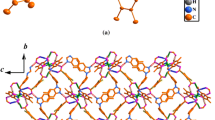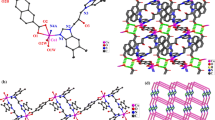Abstract
Supramolecular coordination complex [(Re(CO)3)2(dhnq)(L2)] (3) containing two fac-Re(CO)3 cores, rigid dianionic dhnq (H2-dhnq = 6,11-dihydroxy-5,12-naphthacenedione) motif and semi-rigid ditopic nitrogen donor 1,2-bis(2-nonylbenzimidazol-1-ylmethyl)benzene (o-Nbenzbix = L2) was synthesized. Compounds o-Nbenzbix and 3 were characterized using various analytical and spectroscopic methods. The electrochemical properties of 3 were studied using cyclic voltammetric measurements. SCCs [(Re(CO)3)2(dhnq)(L1)] (1) and [(Re(CO)3)2(dhaq)(L1)] (2) possessing p-xylene spacer 1,4-bis(2-nonylbenzimidazol-1-ylmethyl)benzene (L1) and 1,4-dihydroxy-9,10-anthraquinone (H2-dhaq) were also synthesized as reported previously. SCCs 1–3 were investigated via electrochemical methods. A plot of the Randles-Sevcik equation yielded a straight line for complex 3 thus, establishing that the redox processes were diffusion-controlled.
Graphic abstract
Ditopic N donor containing o-xylene spacer (L2) and its cyclic complex 1 are designed and synthesized. The electrochemical properties of 1 and complexes 2-3 having p-xylene spacer based N donor (L1) are investigated.










Similar content being viewed by others
References
Stang P J and Olenyuk B 1997 Molecular architectures: coordination as the motif in the rational design of supramolecular metallacyclic Acc. Chem. Res. 30 502
Ruben M, Rojo J, Salguero F J R, Uppadine L H and Lehn J M 2004 Grid-type metal ion architectures: functional metallosupramolecular arrays Angew. Chem. Int. Ed. 43 3644
Slone R V, Benkstein K D, Belanger S, Hupp J T, Guzei I A and Rheingold A L 1998 Luminescent transition-metal-containing cyclophanes (“molecular squares”): covalent self-assembly, host-guest studies and preliminary nanoporous material applications Coord. Chem. Rev. 171 221
Sun S S and Lees A J 2002 Transition metal based supramolecular systems: synthesis, photophysics, photochemistry and their potential applications as luminescent anion chemosensors Coord. Chem. Rev. 230 171
Thanasekaran V, Liao R T, Liu Y H, Rajendran T, Rajagopal S and Lu K L 2005 Metal containing molecular rectangles: synthesis and photophysical properties Coord. Chem. Rev. 249 1085
Sun S S and Lees A J 2000 Self-assembly triangular and square Rhenium(I) tricarbonyl complexes: A comprehensive study of their preparation, electrochemistry, photophysics, photochemistry and host-guest properties J. Am. Chem. Soc. 122 8956
Sathiyendiran M, Chang C H, Chuang C H, Luo T T, Wen Y S and Lu K L 2007 Rigidity-modulated conformation control: a strategy for incorporating flexible building motif into metallcycles Dalton Trans. 19 1872
Sathiyendiran M, Wu J Y, Velayudham M, Lee G H, Peng S M and Lu K L 2009 Neutral metallacyclic rotors Chem. Commun. 25 3795
Rajendran T, Manimaran B, Lee F Y, Chen P J, Lin S C, Lee G H, Peng S M, Chen Y J and Lu K L 2001 Self-assembly of tetrametallic square [Re4(CO)12Br4(µ-pz)4] (pz= pyrazine)from [Re(CO)4Br(pz)]. A mechanistic approach J. Chem. Soc. Dalton Trans. 22 3346
Manimaran B, Thanasekaran P, Rajendran T, Liao R T, Liu Y H, Lee G H, Peng S M, Rajagopal S and Lu K L 2003 Self-assembly of octarhenium-based neutral luminescent rectangular prisms Inorg. Chem. 42 4795
Cook T R and Stang P J 2015 Recent developments in the preparation and chemistry of metallacycles and metallacages via coordinaton Chem. Rev. 115 7001
Audebert P and Miomandre F 2013 Electrofluorochromism: from molecular systems to set-up and display Chem. Sci. 4 575
Kaim W 2011 Concepts for metal complex chromophores absorbing in the near infrared Coord. Chem. Rev. 255 2503
Hupp J T 2006 Rhenium-linked multiporphyrin assemblies: synthesis and properties. In: Non-Covalent Multi-Porphyrin Assemblies. Structure and Bonding E Alessio (Ed.) Vol. 121 (Springer: Berlin, Heidelberg) p. 145
Sathiyendiran M, Tsai C C, Thanasekaran P, Luo T T, Yang C I, Lee G H, Peng S M and Lu K L 2011 Organometallic calixarenes: Sycee like tetrarhenium(I) cavitands and tunable size, colour, functionality and coin-slot complexation Chem. Eur. J. 17 9857
Gupta D, Rajakannu P, Shankar B, Hussain F and Sathiyendiran M 2014 Synthesis and crystal structure of a wheel-shaped supramolecular coordination complex J. Chem. Sci. 126 1501
Louie M W, Liu H W, Lam M H C, Lau T C and Lo K K W 2009 Novel luminescent tricarbonylrhenium(I) polypyridine tyramine-derived dipicolylamine complexes as sensors for zinc (II) and cadmium (II) ions Organometallics 28 4297
Partyka D V, Deligonul N, Washington M P and Gray T G 2009 fac-Tricarbonyl rhenium(I) azadipyrromethene complexes Organometallics 28 5837
Si Z J, Li X N, Li X Y and Zhang H J 2009 Synthesis, photophysical properties and theoretical studies on pyrrole-containing bromo Re(I) complex J. Organomet. Chem. 694 3742
Vogler A and Kunkely H J 2000 Excited state properties of organometallic compounds of rhenium in high and low oxidation states Coord. Chem. Rev. 200 991
Lees A J 1998 Organometallic complexes as luminescence process in monitoring thermal and photochemical polymerization Coord. Chem. Rev. 177 3
Wang K Z, Huang L, Gao L H, ** L P and Huang C H 2002 Synthesis, crystal structure and photoelectric properties of Re(CO)3ClL (L= 2-(1-Ethylbenzimidazol-2-yl)pyridine) Inorg. Chem. 41 3353
Lundin N J, Blackman A G, Gordon K C and Officer D L 2006 Synthesis and characterization of a multicomponent rhenium(I) complex for application as an OLED Dopant Angew. Chem., Int. Ed. 45 2582
Ju C C, Zhang A G, Sun H L, Wang K Z, Jiang W L, Bian Z Q and Huang C H 2011 Synthesis, crystal structure and optical and photoelectrochemical properties of a N∩O− rhenium(I) complex Organometallics 30 712
Tsubaki H, Sekine A, Ohashi Y, Koike K, Takeda H and Ishitani O 2005 Control of photochemical, photophysical electrochemical and photocatalytic properties of rhenium(I) complexes using intramolecular weak interactions between ligands J. Am. Chem. Soc. 127 15544
**ong J, Liu W, Wang Y, Cui L, Li Y Z and Zuo J L 2012 Tricarbonyl mono- and dinuclear Rhenium(I) complexes with redox-active bis(pyrazole)-tetrathiafulvalene ligands: Synthesis, crystal structure and properties Organometallics 31 3938
Shankar B, Sahu S, Deibel N, Schweinfurth D, Sarkar B, Elumalai P, Gupta D, Hussain F, Krishnamoorthy G and Sathiyendiran M 2014 Luminescent dirhenium(I)-double-heterostranded helicate and mesocate Inorg. Chem. 53 922
Wright P J, Muzzioli S, Skelton B W, Raiteri P, Lee J, Koutsantonis G, Silvester D S, Stagni S and Massi M 2013 One-step assembly of Re(I) tricarbonyl 2-pyridyltetrazolato metallacalix [3] arene with aqua emission and reversible three-electron oxidation Dalton Trans. 42 8188
Hartmann H, Berger S, Winter R, Fielder J and Kaim W 2000 Reversible and site-specific reduction of the ligand sides in a molecular rectangle with up to eight electrons Inorg. Chem. 39 4977
Wu J Y, Chang C H, Thanasekaran P, Tsai C C, Tseng T W, G H Lee, Peng S M and Lu K L 2008 Unusual face-to-face π-π stacking interactions within an indigo-pillared M3(tpt)-based triangular metalloprism Dalton Trans. 6110
Bhattacharya D, Chang C H, Cheng Y H, Lai L L, Lu H Y, Lin C Y and Lu K L 2012 Multielectron redox chemistry of a neutral, NIR-active, indigo-pilared ReI-base triangular metalloprism Chem. Eur. J. 18 5275
Nagarajaprakash R, Govindarajan R and Manimaran B 2015 One-pot synthesis of oxamidato-bridged hexarhenium trigonal prisms adorned with ester functionality Dalton Trans. 44 11732
Rajakannu P, Shankar B, Yadav A, Shanmugam R, Gupta D, Hussain F, Chang C H, Sathiyendiran M and Lu K L 2011 Adaptation toward restricted conformational dynamics: From the series of neutral molecular rotors Organometallics 30 3168
Dinolfo P H, Coropceanu V, Bredas J L and Hupp T 2006 A new class of mixed-valence with orbitally degenerate organic redox centers. Examples based on hexa-rhenium molecular prisms J. Am. Chem. Soc. 128 12592
Maji S, Sarkar B, Mobin S M, Fiedler J, Urbanos F A, Aparicio A, Kaim W and Lahiri G K 2008 Intramolecular valency and spin interaction in meso- and rac- diastereomers of a p-quinonoids bridged diruthenium complex Inorg. Chem. 47 5204
Haga M, Dodsworth E S and Lever A B P 1986 Catechol-quinone redox series involving bis(pyridine) ruthenium (II) and tetrakis(pyridine) ruthenium (II) Inorg. Chem. 25 447
Peover M E and Davies 1963 The influence of ion-association on the polarography of quinines in dimethylformamide J. Electroanal. Chem. 6 46
Aljabali A A, Barclay J E, Butt J N, Lomonossoff G P and Evans D J 2010 Redox-active ferocene-modified cowpea mosaic virus nanoparticles Dalton Trans. 39 7569
Andrieux C P, Blocman C, Bouchiat J M D, Halla F M and Saveant J M 1980 Homogeneous redox catalysis of electrochemical reactions: Part V cyclic voltammetry J. Electroanal. Chem. 113 19
Bhattacharya D, Sathiyendiran M, Lu T T, Chang C H, Cheng Y H, Lin C Y, Lee G H, Peng S M and Lu K L 2009 Ground and excited electronic states of quinone-containing Re(I)-based rectangles: a comprehensive study of their preparation, electrochemistry and photophysics Inorg. Chem. 48 3731
Bhattacharya D, Sathiyendiran M, Wu J Y, Chang C H, Huang S C, Zeng Y L, Lin C Y, Thanasekaran P, Lin B C, Hsu C P, Lee G H, Peng S M and Lu K L 2010 Quinonoid-bridged chair-shaped dirhenium(I) metallacycles: Synthesis, characterization and spectroelectrochemical studies Inorg. Chem. 49 10264
Gupta D, Shankar B, Elumalai P, Shanmugam R, Mobin S M, Weisser F, Sarkar B and Sathiyendiran M 2014 Synthesis and characterization of a tetrametallic coordination complex of tetrahydroxy-p-benzoquinone J. Organomet. Chem. 754 59
Gosztola D, Niemczyk M P and Svec W 2000 Excited double states of electrochemically generated aromatic imide and diimide radical anions J. Phys. Chem. 104 6545
Goyal R N and Kumar N 1999 Genetic variants in novel pathways influence blood pressure and cardiovascular disease risk Aust. J. Chem. 52 43
Deibel N, Sommer M G, Hohloch S, Schwann J, Schweinfurth D, Ehertand F and Sarkar B 2014 Dinuclear quinonoid-bridged d8 metal complexes with redox-active azobenzene stoppers: electrochemical properties and electrochromic behavior Organometallics 33 4756
Damas A L, Gullo M P, Rager M N, Jutand A, Barbieri A and Amouri H 2013 Near-infrared room temperature emission from a novel class of Ru(II) heteroleptic complexes with quinonoid organometallic linker Chem. Commun. 49 3796
Rajendran T, Manimaran B, Liao R T, Y H Liu, Thanasekaran P, Lin R J, Chang I J, Chou P T, Ramraj R, Rajagopal S and Lu K L 2010 Luminescence quenching of Re(I) molecular rectangles by quinones Dalton Trans. 39 2928
Acknowledgements
Financial support from the Council of Scientific and Industrial Research (CSIR) (01(2793)/14/EMR-II), India is gratefully acknowledged. Dr. B. Shankar is acknowledged for his help. SKG is thankful to the University of Delhi, India for providing R & D grant. MN is grateful to Council of Scientific & Industrial Research (CSIR) and SY is grateful to University Grant Commission (UGC) for fellowship.
Author information
Authors and Affiliations
Corresponding authors
Electronic supplementary material
Below is the link to the electronic supplementary material.
Rights and permissions
About this article
Cite this article
Yadav, S., Natarajan, M., Sathiyendiran, M. et al. Electrochemical aspects of restricted rhenium(I)-based supramolecular complexes with semi-rigid benzimidazolyl and rigid hydroxyquinone ligands. J Chem Sci 132, 1 (2020). https://doi.org/10.1007/s12039-019-1689-3
Received:
Revised:
Accepted:
Published:
DOI: https://doi.org/10.1007/s12039-019-1689-3




